I have used Amazon affiliate links on this page. As an Amazon Associate, I earn a commission from qualifying purchases at no added cost to you. Thank you!
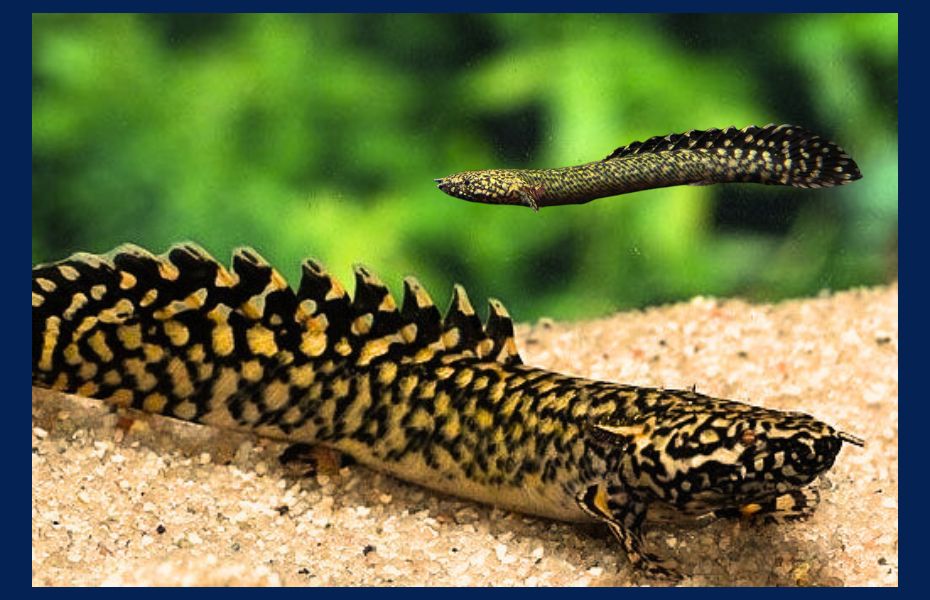
The ornate bichir, also known as the African dragon fish, dinosaur bichir, dinosaur eel, or Polypterus ornatipinnis scientifically, is a unique and fascinating species of fish that makes for a great addition to any freshwater aquarium. With its distinctive appearance and interesting behavior, it is sure to be a conversation starter among visitors. In this guide, we will take a closer look at the ornate bichir, including its scientific taxonomy, natural habitat, diet, size, ideal water parameters, tank size, aqua scaping, behavior and temperament, tankmates, diseases and treatments, disease prevention, breeding, and special care tips.
Table of Contents
Scientific Taxonomy Of Ornate Bichir
The ornate bichir belongs to the family Polypteridae, and the genus Polypterus. It is native to the Congo River basin in Africa and is known for its unique skeletal structure and the presence of dorsal fins that resemble those of a dragon.
This dinosaur fish’s origin can be traced back to approximately 60 million years ago, at the end of the Mesozoic era. Its prehistoric appearance and unique skeletal structure hint at its ancient lineage and adaptation to its environment over millions of years. Being part of the ancient family Polypteridae, the ornate bichir showcases characteristics that have persisted through time, making it a fascinating living relic from the past.
Natural Habitat

The ornate bichir is native to the Congo River basin in Africa, which is a vast region that covers parts of Congo, Angola, the Central African Republic, and the Democratic Republic of Congo. It is home to a wide variety of freshwater habitats, including rivers, swamps, and lakes. The ornate bichir is a freshwater species, and it is primarily found in slow-moving waters with a muddy bottom. The muddy bottom is important as it provides a suitable environment for the ornate bichir to bury itself, which is a behavior they exhibit in the wild.
African dragonfish is known to inhabit a wide range of freshwater habitats, including rivers, swamps, and lakes. In rivers, it can be found in areas with slow-moving water and a muddy bottom. In swamps, it is found in shallow waters, where it can be seen gliding through the vegetation. In lakes, it is found in the shallows, often hiding among vegetation and submerged logs. The ornate bichir is an opportunistic predator, and it can be found in a wide range of habitats, as long as there is an adequate food supply.
It is a hardy species that can tolerate a wide range of water conditions. However, it is important to note that in the wild, the water temperature and water chemistry can vary greatly depending on the season and location. The ornate bichir is able to adapt to these changes by burrowing into the mud and remaining inactive until the water conditions improve. This is one of the reasons why they are a hardy species and can adapt to captivity.
Ornate Bichir Diet
In the wild, ornate bichir is an opportunistic predator, feeding on a variety of small fish, crustaceans, and aquatic invertebrates. They are known to consume a variety of prey items including fish, worms, crustaceans, insects, and mollusks. They are also known to consume plant material in the wild.
In captivity, this bichir will generally eat a variety of live and frozen food, such as bloodworms, brine shrimp, and small pieces of fish or meat. Live food, such as earthworms, or feeder fish, can be offered but should be used sparingly as a supplement to a varied diet. Frozen food, such as bloodworms, brine shrimp, and krill, can also be offered, but again, should be used as a supplement to a varied diet.
Ornate bichirs will also accept commercial fish food, such as pellets or flakes. It is important to choose a high-quality, protein-rich diet that is appropriate for the size and species of the fish. Some commercial fish foods that are suitable for ornate bichirs include: Cichlid Pellets or Flakes, Frozen Bloodworms, Brine Shrimp, Krill, Live worms or feeder fish (should be used sparingly)
It is important to note that African dragonfish have a slow metabolism and do not require frequent feedings. They can go for several days without food, so it is important not to overfeed them. Two feedings per week is usually sufficient for adult ornate bichirs.
Dinosaur Bichir Size
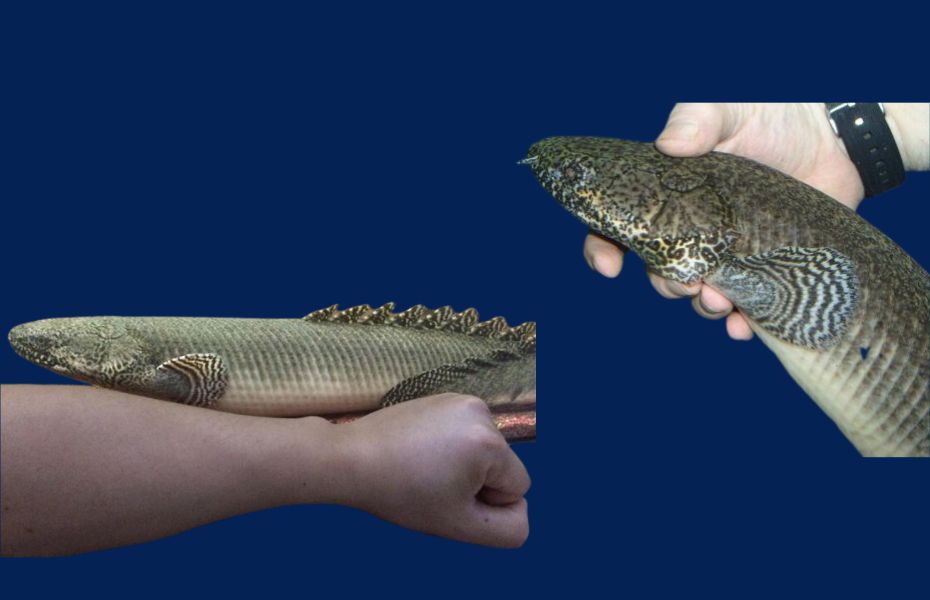
The ornate bichir can grow to be quite large, with females reaching up to 30 centimeters (12 inches) and males reaching up to 45 centimeters (18 inches). In the wild, this can go even further by some male bichir reaching up to 24 inches in length.
Ornate Bichir Ideal Water Parameters
When keeping these bichirs in captivity, it is important to maintain certain water parameters to ensure their health and well-being. The ideal water parameters for ornate bichirs include:
- pH: The pH level should be maintained between 6.5 and 7.8. This is slightly acidic to neutral, and it is important to maintain a consistent pH level to prevent stress on the fish.
- Water temperature: The water temperature should be kept between 77 and 82 degrees Fahrenheit. This is considered to be the optimal range for ornate bichirs, and it is important to maintain a consistent temperature to prevent stress on the fish.
- Water hardness: The water hardness should be between 5 and 20 dGH. The ornate bichir is a hardy species that can tolerate a wide range of water hardness, but it is important to maintain a consistent level to prevent stress on the fish.
- Water flow: A moderate water flow is ideal for ornate bichirs. They are found in slow-moving waters in the wild, and a moderate water flow will help to simulate their natural habitat and prevent stress on the fish.
- Filtration: Good filtration is crucial for maintaining good water quality and preventing the build-up of harmful toxins in the tank. A high-quality filter that is appropriate for the size of the tank is recommended.
It’s also important to perform regular water changes and test the water parameters to ensure that they are within the optimal range for the ornate bichirs. Sudden changes in the water parameters can stress the fish, so it is important to make any necessary adjustments slowly over a period of time.
Ideal Tank Sizes

You might know by now, this bichir is a large species of fish in the aquarium standard that requires a spacious tank in order to thrive in captivity. It indeed falls into the monster fish category due to this reason. Because of its large size when fully grown, a minimum tank size of 55 gallons is recommended for a single ornate bichir. However, as the fish can grow up to 45 centimeters in length, a larger tank of 75 gallons or more is ideal to provide enough room for the fish to swim and grow comfortably.
Aquascaping For Dinosaur Bichir
Aquascaping is an important aspect of keeping any bichir in captivity. It involves creating a visually pleasing and natural environment for the fish to live in. When aqua-scaping a tank for an ornate bichir, it is important to provide plenty of hiding places and cover, such as caves, rocks, and plants. This will help the fish feel more secure and will also provide a more natural environment for it to live in.
One way to create a natural environment in the tank is to use plants that are native to the Congo River basin in Africa, the ornate bichir’s natural habitat. These plants can include Anubias, Java fern, and Hornwort. They can be attached to rocks or driftwood, or planted in the substrate. These plants will not only provide hiding places for the fish but also help to maintain good water quality by absorbing excess nutrients.
Another important aspect of aqua scaping for this african dragonfish is to create a varied landscape with different levels. This can be achieved by using rocks, driftwood, or other materials to create ledges and caves, which will provide hiding places for the fish. It is also important to create a natural flow in the tank, with a moderate water flow that simulates the slow-moving waters of the ornate bichir’s natural habitat.
It’s also important to keep in mind that these bichirs are territorial species and will stake out their own territory in the tank. Therefore, it’s important to provide enough hiding spots and caves to avoid any potential territorial disputes.
Behavior and Temperament
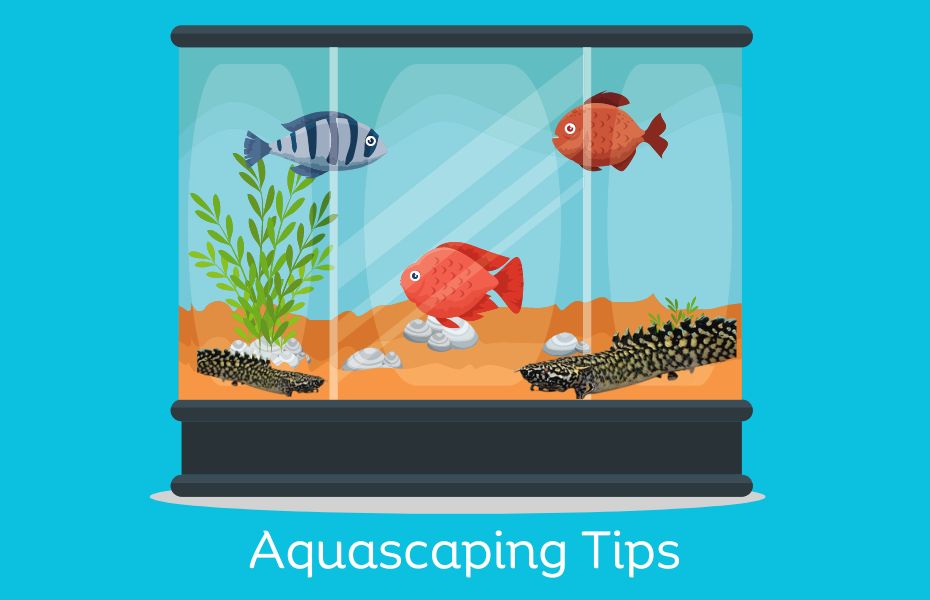
The behavior and temperament of ornate bichirs are quite interesting and unique. They are generally peaceful and solitary fish, but they can become territorial, especially during breeding or if their space is invaded by other fish. Due to their nocturnal nature, they are more active during the night and tend to hide during the day.
The fish is known for their ability to breathe air using a specialized lung-like organ called the labyrinth organ. This allows them to supplement their oxygen intake by breathing atmospheric air at the water’s surface. They will often come to the surface of the water to take a gulp of air, which is an intriguing behavior to observe.
These fish are also skilled jumpers, so it is important to provide a secure lid or cover for the aquarium to prevent them from escaping. Their unique ability to crawl and move across the land for short distances using their pectoral fins and body undulations is another fascinating behavior that showcases their adaptability.
Nocturnal Behaviours
As a nocturnal predator, the ornate bichir exhibits fascinating behaviors that are adapted to its nighttime hunting habits. Here are some details to enrich the behavior section with a focus on its nocturnal nature:
Ornate Bichir Nocturnal Activity:
The ornate bichir is primarily active during the nighttime hours, using its keen senses to navigate and hunt in low-light conditions. It is well-equipped with sensory adaptations, including excellent night vision and a highly sensitive lateral line system, which helps detect subtle water movements and vibrations.
Hunting Strategy:
Under the cover of darkness, the ornate bichir adopts an ambush-style hunting strategy. It remains motionless or moves stealthily among the vegetation, patiently waiting for unsuspecting prey to approach. With its elongated body and fin-like structures, the bichir is capable of moving through tight spaces and maneuvering within vegetation with ease.
Stealth and Patience:
When hunting, the ornate bichir relies on its ability to remain undetected by blending into the surrounding environment. It’s mottled coloration and elongated body shape provide excellent camouflage amidst the shadows and vegetation. The bichir displays remarkable patience, waiting for the perfect moment to strike with lightning-fast speed, surprising its prey.
Ambush and Lunge:
Using its powerful pectoral fins, the ornate bichir launches itself forward in a sudden burst of speed, propelling towards its prey with impressive agility and precision. It captures its prey by opening its large mouth wide and engulfing it in a swift, suction-like motion. The bichir’s sharp teeth ensure a secure grip, preventing the prey from escaping.
Solitary Nature:
Ornate bichirs are typically solitary creatures, preferring to hunt and explore their surroundings on their own. They establish their territories within the aquarium or their natural habitat, patrolling the area during the night to maintain their dominance and secure ample food resources.
Nocturnal Adaptations:
Beyond their hunting behavior, ornate bichirs possess physiological adaptations that enhance their nocturnal lifestyle. They have specialized sensory organs, such as a highly developed olfactory system, allowing them to detect scent trails left by potential prey. Additionally, their nocturnal behavior helps minimize competition with diurnal species, giving them a distinct advantage in accessing food resources during the night.
Observing the ornate bichir’s nocturnal behavior in an aquarium setting can be a captivating experience. Providing low-light conditions and ensuring the presence of suitable hiding spots and vegetation will allow the bichir to exhibit its natural hunting instincts and behavior, giving enthusiasts a glimpse into the fascinating world of this nocturnal predator.
Ornate Bichir Tankmates
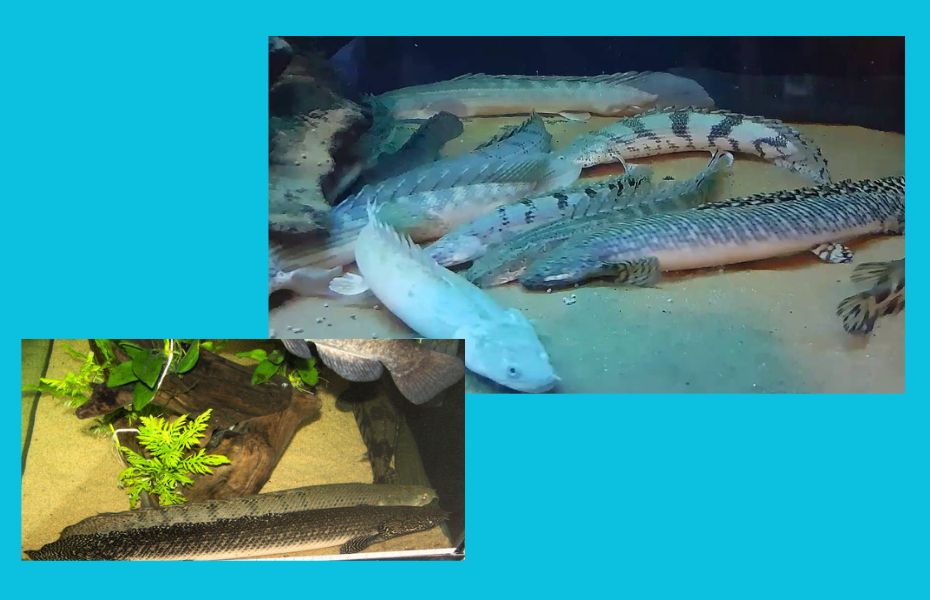
When choosing tankmates for ornate bichirs, it is important to consider their size, temperament, and compatibility with the bichir’s unique needs. They should be kept with fish that are similar in size or larger to avoid the possibility of the bichir considering them as food.
Peaceful and non-aggressive fish that can coexist with ornate bichirs include larger tetras, larger barbs, gouramis, larger catfish species, and other similarly sized non-aggressive species. It is important to avoid keeping them with small fish or fin-nipping species that may harass or stress the bichir. Chinese high-fin shark can be a great monster fish tankmate to this bichir.
It’s worth noting that ornate bichirs have a predatory instinct and may eat smaller tankmates that can fit in their mouth. Therefore, careful consideration should be given to the size and compatibility of tankmates to ensure the well-being of all inhabitants.
Diseases and Treatments
Like any fish species, ornate bichirs are susceptible to certain diseases and health issues. Some common diseases that can affect them include bacterial infections, fungal infections, and parasitic infestations. It is crucial to closely monitor the fish for any signs of illness, such as changes in behavior, loss of appetite, abnormal swimming patterns, or physical symptoms like lesions or discoloration.
If any health issues are observed, it is recommended to quarantine the affected fish and seek appropriate treatment. Consulting with a veterinarian experienced in fish health or an aquatic specialist can provide guidance on suitable medications and treatments for specific diseases.
Ornate Bichir Disease Prevention
Preventing diseases is always preferable to treating them. Maintaining a clean and well-maintained aquarium is the first line of defense against diseases. Regular water changes, proper filtration, and maintaining stable water parameters are essential in promoting fish health.
Quarantining any new fish before introducing them to the main aquarium can help prevent the introduction of potential diseases to the established population. It is also important to avoid introducing wild-caught fish or plants to the aquarium, as they may carry diseases or parasites.
Feeding a varied and nutritious diet to the ornate bichirs will help strengthen their immune system and overall health. Providing a stress-free environment with adequate hiding places and suitable tankmates will also contribute to their well-being.
Lifespan
The lifespan of an ornate bichir can vary depending on various factors, including its living conditions and overall care. In captivity, with proper care and a suitable environment, an ornate bichir can live an average of 10 to 15 years. However, it is important to note that some individuals have been known to live even longer.
In the wild, their lifespan can be influenced by several factors. One key factor is the availability of food. If the bichir has access to a consistent and plentiful food source, it may have a better chance of reaching its maximum lifespan. Additionally, the absence of threats or predators can contribute to a longer lifespan in the wild.
It is worth mentioning that as a fish species, this bichir species’ lifespan is relatively long compared to some other aquarium fish. This allows fishkeepers to enjoy their presence and observe their behavior for an extended period.
How to maximize the ornate bichir lifespan?
To ensure the best possible lifespan for an ornate bichir in captivity, it is crucial to provide appropriate care. This includes maintaining optimal water conditions, providing a balanced and varied diet, offering adequate space in a properly sized aquarium, and minimizing stress factors such as aggressive tankmates or sudden changes in the environment. Regular monitoring of the bichir’s health and prompt attention to any signs of illness or disease can also contribute to a longer and healthier lifespan.
Ornate Bichir Breeding
Breeding ornate bichirs in captivity can be a challenging task due to their specific breeding requirements and the difficulties in determining the sex of the fish. Sexually mature males may exhibit broader and longer pectoral fins compared to females, but this is not always a reliable indicator.
To induce breeding, it is recommended to simulate the rainy season conditions they experience in their natural habitat. This can be achieved by gradually raising the water temperature and increasing the water flow in the tank. Providing suitable spawning sites such as caves or PVC pipes can encourage the bichirs to lay their eggs. Hence, it is important to create the right conditions to encourage successful breeding and ensure the survival of the fry.
During the spawning process, the male will typically guard the eggs until they hatch. Once the fry hatch, they are initially quite small and fragile, requiring special care and a dedicated rearing tank with suitable food and water conditions.
Here are some additional details to enrich the breeding section:
Ornate Bichir Breeding Rituals and Spawning Sites:
The breeding rituals of ornate bichirs can last for a day or longer. The male bichir will actively chase the female and bump into her with his snout as part of courtship behavior. The female will seek out a suitable spawning site before depositing the eggs. To encourage successful spawning, it is recommended to provide a heavily planted aquarium with bushy and fine-leaved plants. These plants serve as suitable sites for the female to deposit her eggs. Additionally, the use of specially designed spawning mops can be beneficial in collecting and protecting the eggs.
Egg Deposition and Fertilization:
The female ornate bichir will deposit a batch of eggs over several days, typically ranging from 100 to 300 eggs. She deposits a few eggs at a time, and the male fertilizes them by cupping his anal and caudal fins around the female’s genital area. After fertilization, the eggs are scattered and attached to the plants. Each egg is approximately 2-3 millimeters in size and slightly adhesive, allowing them to stick to the plants until hatching. It is worth noting that ornate bichirs may exhibit cannibalistic behavior, so removing the parents from the aquarium once the final fertilization is completed can help protect the eggs.
Ornate Bichir Fry Care:
The fry of ornate bichirs has external gills and relies on a yolk sac for nourishment initially. It is recommended to wait for approximately a week before starting to feed the fry, as they need to consume their entire yolk sac before feeding. Initially, small live foods such as newly hatched brine shrimp (Artemia nauplii) or micro worms should be provided. These foods can be placed near the fry to facilitate feeding, as newly hatched bichir fry are not highly active hunters. As the fry grows, it is important to monitor them closely for cannibalistic behavior. To ensure a higher overall survival rate, larger fry should be separated from smaller fry as they develop.
By providing suitable spawning sites, closely observing the breeding rituals, and offering appropriate care to the fry, you can increase the chances of successful breeding and raise healthy ornate bichir offspring.
Special Care Tips
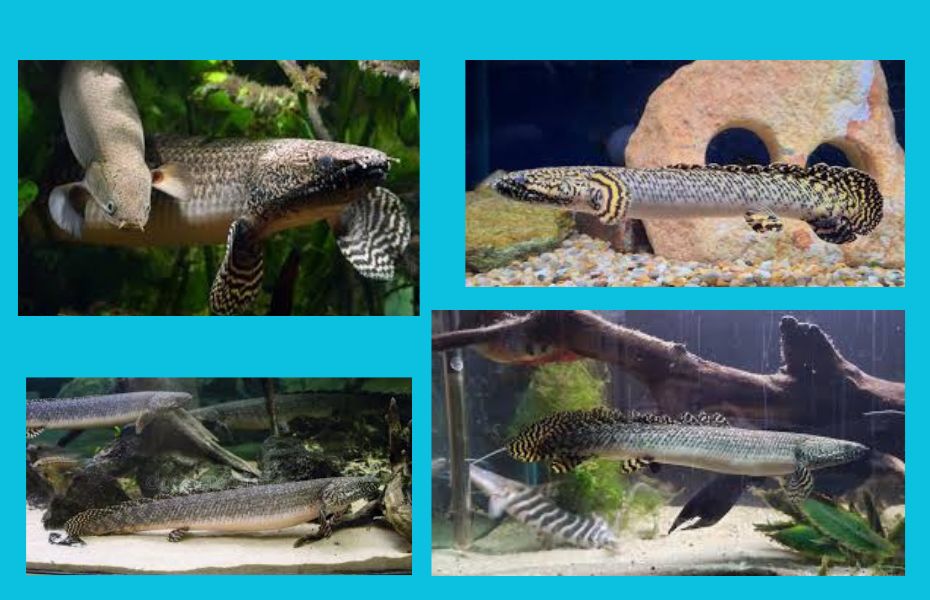
Special care tips for the ornate bichir can help ensure their health, well-being, and longevity. Here are some additional tips to enrich the special care section:
- Tank Cover: Ornate bichirs are known to be skilled jumpers, so it is essential to provide a secure tank cover. A tight-fitting lid or mesh cover will prevent them from escaping the aquarium and protect them from potential injuries.
- Substrate: When selecting a substrate for the aquarium, choose a soft and sandy substrate. Ornate bichirs have a habit of burrowing into the substrate, so avoid rough or sharp substrates that could potentially injure their delicate undersides.
- Hiding Places: Create ample hiding spots and caves within the aquarium. Ornate bichirs appreciate hiding and resting areas, especially during daylight hours when they may feel more vulnerable. Driftwood, rocks, and PVC pipes can be used to create secure hiding places.
- Feeding Behavior: Since ornate bichirs are primarily nocturnal, consider feeding them during the evening or right before lights out. This aligns with their natural feeding behavior and allows them to fully enjoy their meals.
- Dim Lighting: Provide subdued or dim lighting in the aquarium. Ornate bichirs are more active and comfortable in low-light conditions, which mimic their natural habitat. Avoid bright lighting that may cause stress or discomfort.
- Tankmates: Carefully select tankmates for ornate bichirs. Due to their predatory nature and territorial tendencies, it is best to avoid keeping them with small or slow-moving fish that could become potential prey. Suitable tankmates include larger, robust species that can withstand the bichir’s presence.
- Water Quality: Maintain excellent water quality by performing regular water changes and monitoring the parameters. Ornate bichirs are sensitive to poor water conditions, so it is crucial to keep ammonia, nitrite, and nitrate levels in check. Test the water regularly and address any issues promptly.
- Disease Prevention: Quarantine any new fish or plants before introducing them to the main aquarium. This helps prevent the introduction of diseases or parasites that could harm the ornate bichir. Additionally, maintaining a clean and well-maintained aquarium with proper filtration and regular maintenance can significantly reduce the risk of diseases.
- Handling with Care: When handling the ornate bichir, exercise caution and be gentle. Their delicate fins and scales can be easily damaged or injured. If necessary, use a soft net or container to transport them during tank maintenance or when moving them to a different environment.
- Regular Observation: Take the time to observe and familiarize yourself with your ornate bichir’s behavior. Regular observation allows you to detect any changes in their appearance, appetite, or activity levels, which can indicate potential health issues. Promptly address any concerns by consulting with a knowledgeable aquarium professional or veterinarian.
By implementing these special care tips, you can provide a suitable and nurturing environment for your ornate bichir, promoting their overall health and well-being. Remember that each fish is unique, so it’s important to monitor and adjust care practices based on the specific needs and behaviors of your individual ornate bichir.